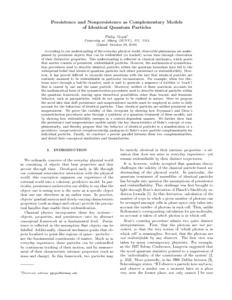Goyal, Philip
(2018)
Persistence and Nonpersistence as Complementary Models of Identical Quantum Particles.
[Preprint]
![[img]](https://philsci-archive.pitt.edu/15220/1.hassmallThumbnailVersion/Complementarity%20of%20Persistence%20and%20Non-Persistence%20%2829%20October%202018%29.pdf)  Preview |
|
Text
Complementarity of Persistence and Non-Persistence (29 October 2018).pdf
Download (2MB)
| Preview
|
Abstract
According to our understanding of the everyday physical world, observable phenomena are underpinned by persistent objects that can be reidentified (or tracked) across time by observation of their distinctive properties. This understanding is reflected in classical mechanics, which posits that matter consists of persistent, reidentifiable particles. However, the mathematical symmetrization procedures used to describe identical particles within the quantum formalism have led to the widespread belief that identical quantum particles lack either persistence or reidentifiability. However, it has proved difficult to reconcile these assertions with the fact that identical particles are routinely assumed to be reidentifiable in particular circumstances. For example, when two electrons move through a bubble chamber, each is said to generate a sequence of bubbles (a 'track') that is caused by one and the same particle. Moreover, neither of these assertions accounts for the mathematical form of the symmetrization procedures used to describe identical particles within the quantum framework, leaving open theoretical possibilities other than bosonic and fermionic behavior, such as paraparticles, which do not appear to be realized in nature. Here we propose the novel idea that both persistence and nonpersistence models must be employed in order to fully account for the behaviour of identical particles. Thus, identical particles are neither persistent nor nonpersistent. We prove the viability of this viewpoint by showing how Feynman's and Dirac's symmetrization procedures arise through a synthesis of a quantum treatment of these models, and by showing how reidentifiability emerges in a context-dependent manner. We further show that the persistence and nonpersistence models satisfy the key characteristics of Bohr's concept of complementarity, and thereby propose that the behavior of identical particles is a manifestation of a persistence-nonpersistence complementarity, analogous to Bohr's wave-particle complementarity for individual particles. Finally, we construct a precise parallel between these two complementarities, and detail their conceptual similarities and dissimilarities.
Available Versions of this Item
-
Persistence and Nonpersistence as Complementary Models of Identical Quantum Particles. (deposited 29 Oct 2018 20:01)
[Currently Displayed]
Monthly Views for the past 3 years
Monthly Downloads for the past 3 years
Plum Analytics
Actions (login required)
 |
View Item |




